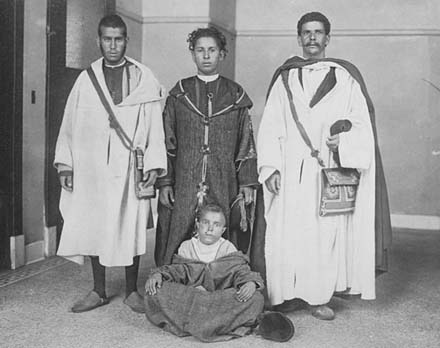|
|
LITR 5831 Seminar in World / Multicultural Literature:
|
|
Research Posts (2 installments + review in final exam) (app. 25% of final grade)
![]() First
research post
due
by evening of
Wednesday, 15 June—late (not
very late) submissions accepted if student informs instructor:
whitec@uhcl.edu.
First
research post
due
by evening of
Wednesday, 15 June—late (not
very late) submissions accepted if student informs instructor:
whitec@uhcl.edu.
![]() Window
for email submission of final exam and second
research post:
Wednesday,
6 July-Saturday noon, 9
July.
Window
for email submission of final exam and second
research post:
Wednesday,
6 July-Saturday noon, 9
July.
Content: the best introduction to this assignment is to review previous student submissions at model assignments.
Assignment:
Write and email two “adventures or experiments in research.” These exercises must be relevant to our subject matter but may reflect your personal and professional interests. Try connecting to Literature, but not absolutely required—posts may move into history, sociology, anthropology, etc.
Essential information: Research posts are not essays of literary criticism but reports on your research findings on criticism or history concerning American immigrant literature and / or culture.
Most typical mistake: Students want to write a personal analysis of texts we're studying or might study because that's the kind of writing they're familiar with in a Literature course. That approach is an essay, not a report.
Your final exam will summarize and assess these research experiments as part of your overall learning experience.
Only absolute stipulation for content: your subject must have something to do with immigrants or immigration. You cannot write about a minority group (African Americans, Native Americans, indigenous Latino/as in American Southwest) without connecting your discussion to the larger subject of immigration. (However, you could write about Afro-Caribbean immigration, Native American migration experiences, or early Spanish-American immigration.) Discuss with instructor.
![]() You may write on the
same topic or related topics for both
posts, but not required. Some students write two posts on
very different topics,
while some students start a topic in their first post and continue it in
the second.
You may write on the
same topic or related topics for both
posts, but not required. Some students write two posts on
very different topics,
while some students start a topic in their first post and continue it in
the second.
Length: at least 4 paragraphs, plus or minus bibliographic information. You may write more than 4 paragraphs, but beyond 6 or 7 paragraphs may push the assignment too far.
Bibliographic requirements and information + Works Cited / Bibliography?
![]() At least 4 sources, at least some of which should be from
reputable scholarship and not just amateur internet postings.
At least 4 sources, at least some of which should be from
reputable scholarship and not just amateur internet postings.
![]() Your sources may include print, Web,
or personal (as in an interview, lecture, conversation, or anecdote). For
interviews, consider calling a former instructor who might know about your
subject, or someone with personal experience.
Your sources may include print, Web,
or personal (as in an interview, lecture, conversation, or anecdote). For
interviews, consider calling a former instructor who might know about your
subject, or someone with personal experience.
![]() You may use
1-2 previous posts from
Model Assignments as research sources, or
look at their sources to find research possibilities.
You may use
1-2 previous posts from
Model Assignments as research sources, or
look at their sources to find research possibilities.
![]() You may also use one of our course's instructional pages (e.g. term-pages).
You may also use one of our course's instructional pages (e.g. term-pages).
![]() Some primary research
may be involved, and you may mention the impact of your research on your own
interests, insights, and conclusions, but your report
mostly summarizes secondary and background research.
(See
primary, background, &
secondary research.)
Some primary research
may be involved, and you may mention the impact of your research on your own
interests, insights, and conclusions, but your report
mostly summarizes secondary and background research.
(See
primary, background, &
secondary research.)
![]() MLA style is
expected, but instructor doesn't
over-emphasize precise documentation style, as it's not the purpose of the
assignment. As long as the instructor can find your source, you're doing "due
diligence."
MLA style is
expected, but instructor doesn't
over-emphasize precise documentation style, as it's not the purpose of the
assignment. As long as the instructor can find your source, you're doing "due
diligence."
![]() Information may be included in text or more completely in listings at
end of post. As the
Model Assignments demonstrate, some research posts feature a Works Cited at the end; others
provide documentation as they cite in the text; and others do some combination.
Information may be included in text or more completely in listings at
end of post. As the
Model Assignments demonstrate, some research posts feature a Works Cited at the end; others
provide documentation as they cite in the text; and others do some combination.
![]() At least a couple sources should be from
reputable scholarship and not just stray internet postings.
At least a couple sources should be from
reputable scholarship and not just stray internet postings.
![]() for
some subjects consider interviews with experts or
practitioners. For instance, some teaching issues may offer little research, so
interview someone who may have more knowledge, like a former teacher or
professor.
for
some subjects consider interviews with experts or
practitioners. For instance, some teaching issues may offer little research, so
interview someone who may have more knowledge, like a former teacher or
professor.
![]()
Organization,
Content, etc.:
Title your entry to serve as a link. Title should indicate content. Title may take the form of a question.
1st paragraph: Introduce and frame a question you want to answer or a topic you want to know more about. Explain source or background of your interest; what you already knew on subject, how or where you learned it or were alerted to it, etc. These backgrounds may be personal as well as educational or professional. At some point in this introductory paragraph, a statement of the question you’re trying to answer should appear.
2nd and 3rd paragraphs: describe your search for answers to your question or topic of interest. Locate, describe, and evaluate at least two sources in some detail.
Your content may change directions according to what you learned instead of what you expected to learn. You may attempt some brief analysis or opinion, but the main purpose is to describe, summarize, and share information in an interesting and readable way.
4th paragraph: What is the answer to your question? Your “answer” may take a variety of forms, as long as you demonstrate learning.
![]() You may find a definite answer to your specific
question.
You may find a definite answer to your specific
question.
![]() You may learn you’ve asked the wrong question, then conclude by revising your question.
You may learn you’ve asked the wrong question, then conclude by revising your question.
![]() Summarize and
evaluate what you have learned, and consider your next step if you
continued research along this line.
Summarize and
evaluate what you have learned, and consider your next step if you
continued research along this line.
![]() These paragraph descriptions above are only guidelines,
not absolute rules.
These paragraph descriptions above are only guidelines,
not absolute rules.
![]()
Your two posts may change subjects or continue a single subject. Remain aware of need to discuss your research posts as part of final exam essay on your overall learning curve.
Choosing a topic or topics: Before either post, welcome to email instructor regarding choice of topic(s) for 1st & 2nd posts. Previewing with instructor does not commit. Topics for research posts evolve as research is carried out.
Grading: Grades for research postings are not returned until Final Grade Report. The grade is based on readability, interest, and quality of research. (By interest, I don’t mean whether I would have chosen the topic, but how well the report generates and sustains interest.)
The first research post will only be replied to with a brief note of receipt and review; your only grade for your research posts will be a composite grade for both. Review further by request or in conference.

early 20c Moroccan immigrants
Official schedule: final class meeting,
7 July 2016, 3-6pm;
email submission window:
6-9 July
Course grades are due to registrar following week; students will receive final grade reports app. 1 week after submission.
Relative weight: 40%(+-) of final grade
Format: Take-home
email exam.
Open-book, open-notebook.
![]() Essay 1:
Review, focus, and extend overall seminar experience to demonstrate learning and
preview potential extensions or applications in research, teaching, or writing
(professional or creative).
Essay 1:
Review, focus, and extend overall seminar experience to demonstrate learning and
preview potential extensions or applications in research, teaching, or writing
(professional or creative).
![]() Essay 2:
Choose a topic from list below, combine 2+ topics, or develop a topic of
your own that refers to course texts and various objectives.
Essay 2:
Choose a topic from list below, combine 2+ topics, or develop a topic of
your own that refers to course texts and various objectives.
(Don't fear some overlap between the two essays; cross-reference for efficiency? Essay 1 might preview Essay 2, and Essay 2 might refer to points made in Essay 1. Manage repetitions efficiently and consciously.)
![]()
Schedule:
Attendance not required on 7 July. Classroom available for
student use.
Submit email exam any time after 6pm, Tuesday,
6
July. Deadline for email submission is noon Saturday,
9 July. If problems, communicate.
Special Requirements:
![]() Title your essays.
Title your essays.
![]() Refer to objectives and
instructional term-pages; develop, challenge, or vary their meanings
in relation to your readings and analysis.
Refer to objectives and
instructional term-pages; develop, challenge, or vary their meanings
in relation to your readings and analysis.
![]() Somewhere in your exam, refer at least once to a final exam from previous
semesters' Model Assignments:
something you learned, disagree with, used as a model. More than one such
reference is often impressive. You may refer to assignments besides the
final exams, including this semester's research posts and midterms. More
than one such reference is impressive and usually helps substantiate or
extend your ideas or examples.
Somewhere in your exam, refer at least once to a final exam from previous
semesters' Model Assignments:
something you learned, disagree with, used as a model. More than one such
reference is often impressive. You may refer to assignments besides the
final exams, including this semester's research posts and midterms. More
than one such reference is impressive and usually helps substantiate or
extend your ideas or examples.
![]() Somewhere in your exam (probably but not exclusively Essay
1), refer to at least one of your research posts as part of your learning
experience or development of special topic.
Somewhere in your exam (probably but not exclusively Essay
1), refer to at least one of your research posts as part of your learning
experience or development of special topic.
![]() No requirement for Works Cited except for special
circumstances.
No requirement for Works Cited except for special
circumstances.
Rationale for Essays 1 & 2
![]() Essay 1 surveys, organizes, and extends a wider range of
learning. Textual references may be more glancing or sweeping.
Essay 1 surveys, organizes, and extends a wider range of
learning. Textual references may be more glancing or sweeping.
![]() Essay 2 goes for deeper focus and detail. Textual examples may
be explored more thoroughly.
Essay 2 goes for deeper focus and detail. Textual examples may
be explored more thoroughly.
Overlap of Essays 1 & 2 with each other and your midterm is not automatically a problem.
You may refer to, extend, or rethink anything you wrote in your midterm; welcome to regard these essay assignments as extensions or complements to your midterm essays and as opportunities to develop ideas you started there.
![]()
Essay 1: Review, focus, and extend overall seminar experience to demonstrate learning and preview potential extensions or applications in research, teaching, or writing (professional or creative).
Relevant course objective: Objective 1: To identify the immigrant narrative as a defining story, model, or social contract and recognize its relations to "the American Dream" and other multicultural narratives and identities.
Because the seminar attempts a comprehensive survey of American multicultural
literature and history, this assignment seeks a similar breadth of response by the student.
You can't cover every possible group in thorough detail, but you can
inter-relate our various groups through their varying relationships to the
Immigrant Narrative and the USA's dominant culture. The
essay will be evaluated on the quality of its writing and reference to our
shared texts and objectives, but also for its attempt to comprehend the multicultural landscape
surveyed by the course.
The following b
![]() What are the pro's and cons of organizing
our seminar subject in terms of the immigrant story as a cultural narrative that
determines American identities, even for those who are not immigrants? What
other narratives may correspond? (rags-to-riches, American Dream, coming-of-age
/ initiation / conversion narrative, liberation / emergence). What other alternatives to current
organization?
What are the pro's and cons of organizing
our seminar subject in terms of the immigrant story as a cultural narrative that
determines American identities, even for those who are not immigrants? What
other narratives may correspond? (rags-to-riches, American Dream, coming-of-age
/ initiation / conversion narrative, liberation / emergence). What other alternatives to current
organization?
![]() What multicultural groups are excluded or alienated by the
immigrant narrative? Given the
numbers of such groups, are other comprehensive organizations possible?
What multicultural groups are excluded or alienated by the
immigrant narrative? Given the
numbers of such groups, are other comprehensive organizations possible?
![]() Potential applications: What potentials and
limits of immigrant experience as an organizing narrative of multicultural
American literature (or, you want to go cultural, the prevailing American
mentality or ideology?
Potential applications: What potentials and
limits of immigrant experience as an organizing narrative of multicultural
American literature (or, you want to go cultural, the prevailing American
mentality or ideology?
References:
![]() At least 4 references to course texts that sample different groups surveyed;
feature at least one minority text to reinforce immigrant-minority distinction
At least 4 references to course texts that sample different groups surveyed;
feature at least one minority text to reinforce immigrant-minority distinction
![]() Review your own research post(s) plus or minus your midterm
or midterms by classmates.
Review your own research post(s) plus or minus your midterm
or midterms by classmates.
![]() Consider references to post-midterm groupings of New World
Immigrants and 19th-20th Century Immigrants:
Consider references to post-midterm groupings of New World
Immigrants and 19th-20th Century Immigrants:
![]() Refer to at least one final exam or other submission from a
previous course.
Refer to at least one final exam or other submission from a
previous course.
Some other content approaches:
![]() What did you learn about American multiculturalism? What
did you come in knowing, and how does studying the Immigrant Narrative &
variations
confirm, challenge, or expand your knowledge?
What did you learn about American multiculturalism? What
did you come in knowing, and how does studying the Immigrant Narrative &
variations
confirm, challenge, or expand your knowledge?
![]() Arrange your essay so that your progress in knowledge or
reading works with some of our groupings like
"model minority" immigrants,
true minorities,
New World immigrants, etc., or if you had a favorite
objective or theme, run with that, but create a big picture of your
understanding in relation to the course.
Arrange your essay so that your progress in knowledge or
reading works with some of our groupings like
"model minority" immigrants,
true minorities,
New World immigrants, etc., or if you had a favorite
objective or theme, run with that, but create a big picture of your
understanding in relation to the course.
![]() Another approach might be to describe the course to a
stranger, a colleague, or a class of your own. But don't describe casually—organize
thematically.
Another approach might be to describe the course to a
stranger, a colleague, or a class of your own. But don't describe casually—organize
thematically.
![]()
Essay 2: Choose a topic from list below, combine 2+ topics, or develop a topic of your own that refers to course texts and various objectives.
![]() Refer to at least 4 texts, one of which may be film or poetry
Refer to at least 4 texts, one of which may be film or poetry
![]() Outside texts OK for brief reference.
Outside texts OK for brief reference.
![]() Connect to at least 1 course objective (or parts).
Connect to at least 1 course objective (or parts).
![]() References to earlier student samples on similar subjects
encouraged but not required.
References to earlier student samples on similar subjects
encouraged but not required.
Topics:
2a. Describe how
2b.
Dominant culture: What glimpses
and insights, with what worth? Why won’t
students recognize or discuss? What are the costs and benefits of identifying
the
2c. Immigrant narrative / experience and family or gender experience; possible focus on women's identities and rights but contextualize with other aspects of immigrant narrative or history. (Obj. 5)
2d. Assimilation, Acculturation, Resistance, hybrid identities? "Assimilation" is widely-known but discredited. "Acculturation" sounds friendlier but is less current, while "hybrid" remains metaphorical rather than common-usage. "Resistance" is always dramatic or romantic but at the potential cost of dialogue or exchange.
2e. Revisit minority-immigrant distinction focusing on
assimilation and intermarriage, possibly starting with
article on intermarriage
and including discussion of mestizo
model of Hispanic culture vs. "purity" model of North American culture,
+ resistance to or variations on inter-racial marriage b/w dominant and minority
cultures. (Obj. 5; model assignment:
Mary Brooks, Love, Honor and
Assimilate
2f.
Should multicultural literary studies emphasize formal excellence or
representative inclusiveness? Should texts be selected for universal excellence
or for marginalized or emergent voices? How much does "universal excellence"
mean dominant-culture values? How much does representative inclusiveness
threaten norms or standards? (Example from final classes: How much is Long
Day's Journey a classic tragedy, and how much an expression of
Irish-American culture?) (Model Assignments:
Carol Fountain,
Formal Excellence v.
Representative Inclusiveness
2g. As a variation on 2f, write an essay on Narrative and Cultural Narrative—with particular focus on the Immigrant Narrative—as an organizing motif for multicultural literature. Some contents may resemble Essay 1's course overview, but concentrate more on narrative theory as a way to teach both fiction and history, both individual and collective stories.
2h. Combine one or more of the options above, or develop a question or topic of your own that refers to course texts and varies objectives. Acknowledge course objective(s) relating to your subject.
Model Assignments for 2h:
Carlos Marquina, The Gatekeepers
Evaluation criteria for essays: Readability & surface competence, content quality, and unity / organization.
Readability & surface competence: Your reader must be able to process what
you're reporting. Given the pressures of a timed writing exercise, some rough
edges are acceptable, but chronic errors or elementary style can hurt.
Content quality:
Comprehension of subject, demonstration of learning, + interest & significance:
Make your reader *want*
to process your report. Make the information
meaningful; make it
matter
to our study of literature and culture. Reproduce course materials,
especially through reference to terms, instructional pages, and objectives, but
also refresh with your own insights and experiences. Avoid: "You could have
written this without taking the course."
Thematic
Unity and Organization:
Unify materials along a line of thought that a reader can follow from start to
finish. (Consider "path of learning": what you started with, what you
encountered, where you arrived.)
Evidence & extension of learning: All exams must competently use central terms and themes from objectives with text-examples from lecture-discussion or your own reading. Knowledge beyond the course and on-the-spot inventiveness are impressive, but establish mastery of our course’s essential materials. Beware being told, "You could have written this essay without taking the course." As for extension of learning, the best exams comprehend but also refresh the course’s terms, objectives, and texts with the student's voice, insights, and examples from and beyond our course.



